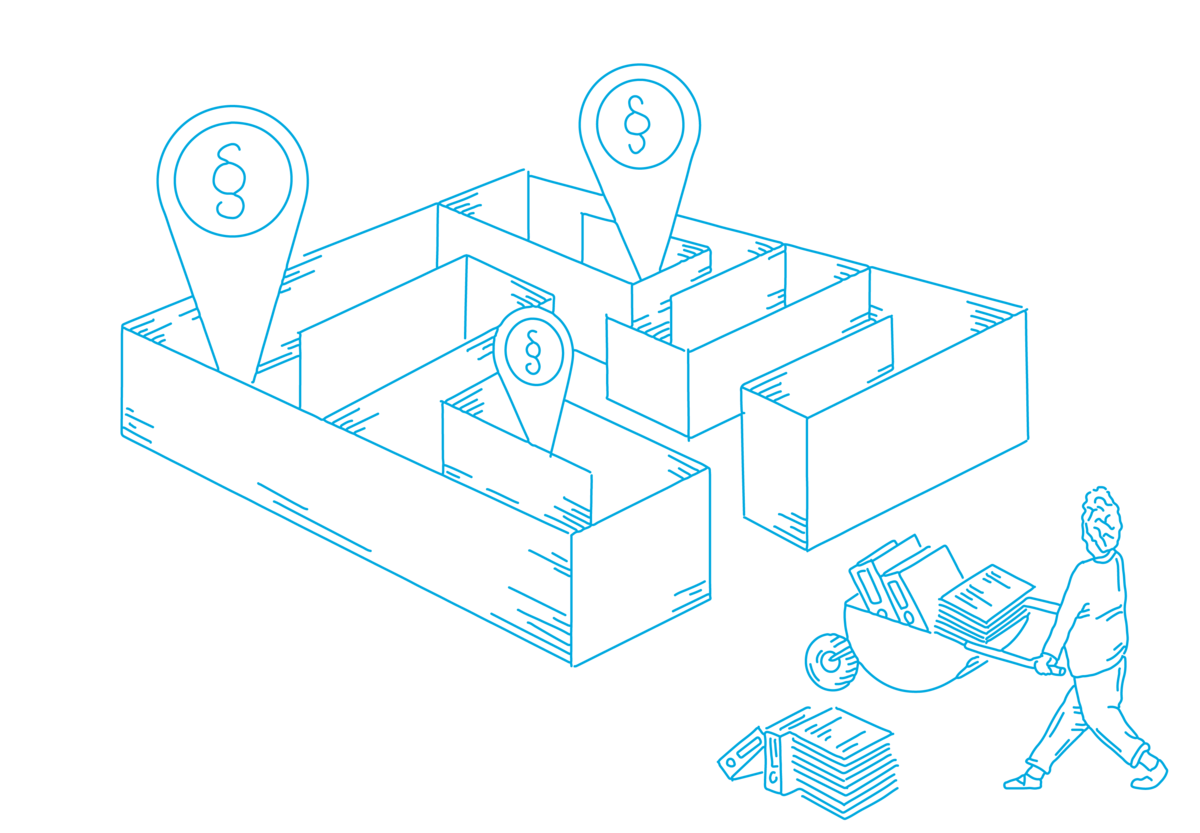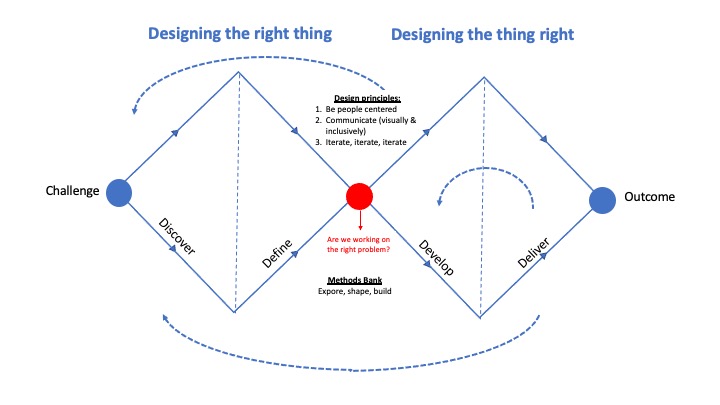
Design Thinking - Solving complex problems in agile and collaborative way
Design thinking is an innovative approach that leverages collaboration in work and learning to solve complex problems. The necessary mindsets and methods that enable management to become more agile and digital are presented in the following.
Summary |
|
The coalition agreement of 2021 sets out the agenda to make public administration in Germany more digital and agile. Quite apart from the scale of ambition, this is a challenge because agile methods are not common knowledge – and where they are, they are often rejected – in the halls of German public bureaucracies. In many respects, agile methods question the traditionally hierarchical design of a public administration that strives for resilience and linear processes that enable transparency and accountability through clear distribution of roles and responsibilities. Nevertheless, new organizational units such as the OZG Digital Labs, the Digital Service 4Germany Fellowships, the Agile Coaches at the BMAS, as well as other training formats through the Federal Digital Academy have already successfully introduced public administrations to agile methods (such as, for example, design thinking). However, many of the required skills are unclear and inherited administrative traditions often become obstacles to the transfer of agile methods from experimental spaces to daily routines. This results in cognitive dissonance as the rest of the organization continues to work in a linear fashion, relying on negative coordination rather than cross-silo collaboration. Design thinking applies the methods and mindsets of innovative product design to organizational challenges (e.g., agile organizational development, digital transformation, or policy issues such as urban transportation infrastructure development). Agile methods like design thinking or lean start-up leverage the creative potential of small, multidisciplinary teams tackle highly complex challenges. This paper, then, provides an overview of the mindset, underlying principles, and methods that can help administrative units identify training needs and support discussions with external service providers.
Fields of Application
Agile methods are not suitable for all administrative problems. Indeed, they do best when directed at problems with no established procedures, few if any routines and expectations, and no ready set of "good practices" to fall back upon. Presently, strategic planning works through predefined project phases while assuming access to complete information as well as a high degree of certainty in planning - comparable to constructing motorway sections.
In contrast, design thinking helps actors explore problems for which there is no planning certainty or previous experience. These include so-called ‘wicked problems’ (Webber & Rittel, 1973) – that is, problems that are too complex for a single actor to solve alone, for which knowledge is uncertain and existing solutions are highly contested (March, 1991). The obverse of wicked problems are so-called "tame problems": these are far more amenable linear or mono-disciplinary problem-solving approaches. Wicked problems that public administration currently face include, for example, the digital transformation of administrative processes, pandemic vaccination strategies as well as the regulation of hate speech on the Internet. The successful application (or, to use James March’s terminology the ‘exploitation’) of existing procedures and skills also implies the ability to adapt to new challenges and to explore new ways of solving problems (or, in James March’s terminology, to ‘explore’). This kind of ambidexterity often gives rise to problems of application to and transfer into organizational practices.
Design Thinking Approach
Design thinking is driven by two core mindsets: user-centeredness and servant leadership.
User-Centeredness and Empathy:
Traditionally, public administrations address problems primarily in terms of existing political guidelines or internal best practices (or both). As a result, users experience these solutions only after they have been released into the public sphere. A user-centered approach, in turn, advocates the early involvement of users in the design process. In the context of public administration, which typically deals with policy challenges, these empathy-based design processes are comparable to other types of participatory approaches occasionally prescribed by law. Design thinking practices enable participation along a spectrum: at one end, stakeholders participate in the design process as team members; at the other end of the spectrum, design teams vicariously incorporate stakeholder perspectives (e.g., as data from qualitative interviews with stakeholders). This helps ensure the design process revolves around user (or citizen) needs rather than the needs of administrative units or policy makers.
Servant Leadership
Effectively focusing on user needs implies a change in leadership practices. Instead of top-down hierarchical management approaches, leadership needs to embrace the notion that seniority and status do not trump user needs (the users in this case being team members). In practice, the idea of ‘servant leadership’ has provided public sector managers with a useful set of concepts (Liden et al., 2008). On this view, leaders help their teams understand stakeholder needs to then create experimental spaces in which to develop innovative yet evidence-based solutions. These solutions are then tested and iterated in short, agile developmental cycles. The concept of ‘servant leadership’ recognizes that command-and-control growth opportunities are limited and work to remove barriers to their own teams. They allow autonomy for self-directed teams, delegating decision preparation and implementation to the teams. To maximize their self-efficacy, it is necessary to create an atmosphere in which teams are not afraid to address unpopular issues/mistakes. This type of leadership requires a certain form of risk-taking and a departure from status preservation thinking. Leaders must be able to accept uncertainty in the process and of possible outcomes. Moreover, they need to trust in the ability of the methods to lead to the appropriate outcomes. On the one hand, this attitude is a consequence of the understanding that one is dealing with wicked problems or highly complex problems that cannot be solved from a mono-disciplinary point of view. On the other hand, it also provides an orientation for action in order to avoid a paralysis of the solution teams before the complexity of Wicked Problems - the Paralysis through Analysis. A team that accepts uncertainty in both problem definition and solution finding also knows that it must move quickly into the build-measure-learn cycle to gather the insights that support workable solutions (see Figure 1).
Figure 1: Build-Measure-Learn Cycle
Recommendations for action |
|
Design thinking methodology
In general, the Design Thinking approach can be divided into two phases, whereby a problem is first explored in repetitive cycles, which can then lead to a methodically guided solution finding process
Problem exploration before solution finding (diverging): In the problem exploration phase, the following action maxim applies, resulting from the uncertainty and complexity of the Wicked Problems: avoid postulating solutions or solution approaches without critically questioning the challenge (or the supposed problem or task), to examine it in depth, and to remain open to the design of the problem. In this process, the assumptions and knowledge in the design team about the challenges of the users are explicitly addressed and critically examined. The team members work out their underlying assumptions with each other and reflect on them in an inter- and multidisciplinary exchange. The objective is not to agree on a common problem definition for the team. Rather, the aim is to identify and present the potential for conflict and friction between the various assumptions. In addition, the assumptions and knowledge about the problems of the users are confronted with the perspectives and life worlds of the users through user research, with the help of qualitative methods of the social sciences. he team's reflection and the confrontation with the users' perspectives enable the design team to reveal new lines of sight on complex challenges and thus to open up new or innovative solution spaces. Only when the challenge has been redefined (often referred to as Creative Reframing) do design teams turn to finding a solution. Here, problem exploration is at least as important (if not more important) and time-consuming as the solution-finding process.
Solution space exploration including prototyping (converging):
In the solution space, design teams use ideation methods such as various brainstorming techniques to populate the newly defined solution space with as many ideas as possible. Since, as we have seen, multidisciplinary collaboration does not eliminate or neutralize the inherent uncertainty of complex problems - the so-called Wicked Problems - ("only" enables practical approaches to these problems), design teams in this phase aim to generate as many radical ideas as possible. This collection of ideas and potential solutions (the larger and more radical the collection, the better) reflects the recognition (or acceptance) that complex problems and their potential solutions involve fundamental uncertainty. Every solution idea is a hypothesis which must first be empirically tested for usefulness. Prototypes that can be experienced, tested and improved with users are suitable for this purpose. User tests allow the design team to gain new insights into their solutions, the prototypical implementation of the solution, and (inevitably) into the users themselves and their lifeworld. In this sense, user tests (analogous to the process of creative reframing in the problem space) are a gateway to or a way back into the problem space (see Figure 2).

Figure 2: Double-Diamond-Modell from the Design Council (Design Council, UK)
Design Thinking Principles
The Design Thinking procedures can be derived from the principles of Design Thinking as a solution process for Wicked Problems. Wicked problems, as already mentioned, are characterized by both high complexity and profound uncertainty. The basic principles of design thinking address these two characteristics: Multidisciplinary collaboration allows for constructive engagement with complexity, while iterative problem-solving allows for pragmatic engagement with the fundamental uncertainty of these challenges. Multidisciplinary collaboration: If we assume that agile working methods such as design thinking are particularly suitable for solving complex problems, then a correspondingly large number of problem-solving skills must be represented in the teams. The term "multidisciplinary" - actually a term from the university or scientific environment - can be perceived as a barrier to the implementation of agile methods. This type of collaboration is less about an interaction of people with qualifications from different academic disciplines than about a collaboration of people with different and ideally conflicting perspectives on a complex problem in the design process. In public administration, this can include not only diverse expertise from different departments, but also perspectives that result from different life experiences and situations of citizens. e objective of this collaboration is to deal with the complexity of Wicked Problems by creatively integrating and synthesizing as many different perspectives as possible. Iterative solution development: In addition to complexity, Design Thinking teams also have to deal with the knowledge ambivalence of Wicked Problems. Here, the "uncertainty of knowledge" does not indicate ignorance, i.e., a lack of knowledge. On the contrary, there is often a great deal of knowledge (both scientific and otherwise) about Wicked Problems-such as climate change, child poverty, homelessness, or crime. Uncertainty" in this case means that this knowledge is not necessarily actionable, or that the implications of action still leave much room for interpretation - and thus for discussion n short, although we know a lot about Wicked Problems, we argue about how to translate this knowledge into effective solutions and actions. However, applicability is not necessarily eliminated by collaboration in multidisciplinary teams. In other words, the new user-centered viewpoint with which teams look at complex problems that emerge from the process of creative reframing is not based on an absolute claim to truth. At best, these are hypotheses about how the complex problems at hand could be sensibly addressed. By quickly translating insights into ideas and in turn into tangible prototypes, design teams are able to confront their hypotheses relatively quickly with (empirical) data through user testing. This is actually not a validation in the strict scientific sense, but a first falsification: Ideally, design teams actively search for errors and misinterpretations as well as for weaknesses and potential causes that could have led to a failure of the idea/solution. This implies that the failure of a solution is actively caused and provoked in experimental test environments. Accordingly, iterative work - the process represented by the build-measure-learn cycle - is not the "one" course of action (in case the idea does not work out), but an integral part of the innovative way of working: Without iteration, there is no real Design Thinking. For the public administration, these internal tests are immensely important, because failure happens, if possible, not at the time of the actual publication of a solution, but long beforehand, and the design teams can make improvements (see Figure 3).
| Phase | ||
| Problem space | Solution space | |
Design- Thinking methods | Diverging/Exploring: Understanding and observing
| Diverging/Developing: Finding ideas
Converge/Create: Prototype and testing
|
|
Figure 3: Overview of methods per Design Thinking phase
Literature
Bason, C. (2010): Leading Public Sector Innovation: Co-Creating for a Better Society, Polity Press, Bristol, UK.
Design Council (o. A.): What ist the framework for innovation? Design Councils evolved Double Diamond, go.sn.pub/fQOC0p
Lewrick, M., Link, P., Leifer, L. (2017): Das Design Thinking Playbook: mit traditionellen, aktuellen und zukünftigen Erfolgsfaktoren, München.
Liden, R. C., Wayne, S. J., Zhao, H., Henderson, D. (2008): Servant Leadership Scale, The Leadership Quarterly.
Martin, R. L., (2009): The opposable mind: Winning through integrative thinking, Cambridge, Massachusetts.
Norman, D. (2013): The design of everyday things: Revised and expanded edition, Basic books.
Ries, E. (2011): The Lean Startup. New York.
Rittel, H., Webber, M. (1973): Dilemmas in a General Theory of Planning, Policy Sciences, 4, S. 155-69.
Dr. Steven Ney

